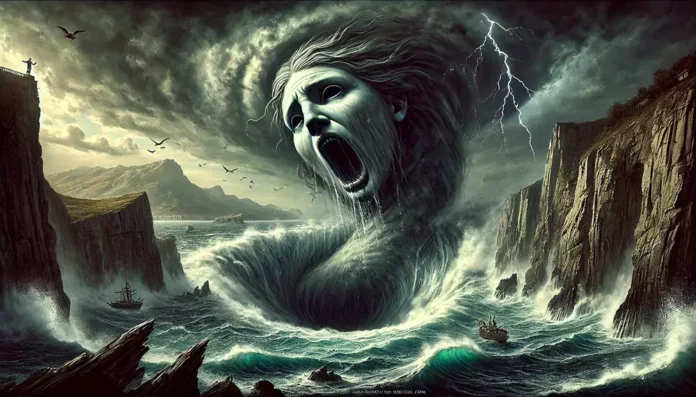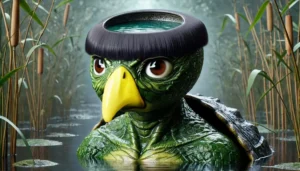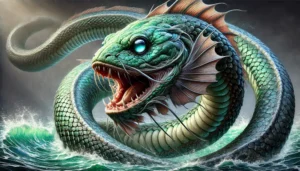Introduction
Charybdis, the monstrous whirlpool of Greek mythology, is feared as an unstoppable force of nature, a creature that swallowed entire ships with her whirlpool. Dwelling in the narrow straits opposite Scylla, Charybdis was a constant menace to sailors who had to navigate treacherous waters between these two threats. Symbolizing the unpredictability and ferocity of the sea, Charybdis became a powerful metaphor for unavoidable risks and natural destruction.
History/Origin
Charybdis first appears in Homer’s Odyssey, where she is introduced as a monstrous whirlpool, endlessly sucking in and spewing out water. According to myth, Charybdis was once a nymph, the daughter of Poseidon and Gaia, who was cursed by Zeus. The transformation into a sea monster occurred after Charybdis aided her father in expanding his realm by flooding large areas of land. Angered by her greed, Zeus condemned her to the sea as a whirlpool, forever bound to swallow and regurgitate the waters of the strait.
The origins of Charybdis likely draw from ancient sailors’ observations of real whirlpools and turbulent waters in the Strait of Messina, a notoriously dangerous part of the Mediterranean. Her myth served as both a cautionary tale and a personification of maritime perils.
Name Meaning
The name “Charybdis” (Greek: Χάρυβδις) translates loosely to “the one who swallows” or “devourer.” This fitting title encapsulates her monstrous appetite for water, ships, and anything unfortunate enough to fall within her grasp. The word has come to symbolize an insatiable force, one that is relentless and impossible to escape.
“To face Charybdis is to confront the abyss, a reminder that some battles are best avoided.” (Ancient Proverb)
Background Story
Charybdis’ most famous story unfolds in Homer’s Odyssey, where Odysseus must navigate between her and Scylla. Sailing through the narrow strait, Odysseus faces a harrowing choice: either risk his men to Scylla’s ravenous heads or tempt fate with Charybdis, who could swallow his entire ship. He opts for the lesser evil, steering closer to Scylla to avoid Charybdis’ deadly maw.

This episode illustrates Charybdis as more than a physical threat; she represents the impossible choices that life sometimes presents. Her presence in the strait serves as a testament to the risks sailors took, balancing the whims of nature and the dangers of the sea.
Cultural Impact
Charybdis became a symbol of maritime dangers, embodying the perils sailors faced on the open sea. Ancient Greek navigators would invoke her name as they passed through treacherous waters, associating her with real whirlpools and powerful currents. Charybdis’ mythical presence emphasized the respect and fear ancient Greeks held for the sea’s unpredictable might.
In art, Charybdis wasn’t depicted as a creature with form but rather as a fearsome vortex, a gaping maw of water ready to consume anything in her path. Pottery, mosaics, and poetry alluded to her power as a representation of the natural world’s dangers, and her name became a byword for the chaotic and the insurmountable.
Similar Beasts
Charybdis isn’t the only mythological creature that represents nature’s raw, unrestrained power. In Norse mythology, Jörmungandr, the World Serpent, embodies destructive ocean forces, encircling the Earth and threatening to unleash chaos when disturbed. Similarly, Hindu mythology describes Makara, a sea monster that guards river mouths, symbolizing both protection and deadly danger.
In Japanese folklore, the Funayūrei are vengeful spirits of sailors who create whirlpools to drag ships down. These figures, like Charybdis, represent the unpredictable and perilous nature of the sea, reminding sailors of the thin line between safety and disaster.
Religion/Ritual
Though Charybdis herself wasn’t a deity, her association with Poseidon and her role in mythology made her a respected force among sailors. Prayers and offerings to Poseidon often included pleas for safety from Charybdis’ wrath. Sailors would sacrifice to the sea gods to protect them from the dangers represented by both Charybdis and Scylla.
In ancient Greece, offerings to Poseidon and other sea deities were common practices for those embarking on maritime journeys. Rituals often included pouring libations into the sea or sacrificing livestock, seeking protection from deadly forces like Charybdis.
Scientific or Rational Explanations
The myth of Charybdis may have its roots in real maritime phenomena, particularly the powerful whirlpools and currents found in places like the Strait of Messina. This area of the Mediterranean, located between Italy and Sicily, has currents strong enough to create whirlpools under certain conditions, likely inspiring stories of a monstrous entity devouring ships.
Ancient Greeks, without an understanding of oceanography, might have interpreted these whirlpools as the work of supernatural beings. Charybdis, then, served as a way to explain and respect the power of the sea, a force that even the strongest vessels could not defy.
“Charybdis is the primal reminder that nature, in all its beauty, also holds a terrifying might beyond human control.” – Ancient Maritime Lore
Modern Cultural References
Charybdis’ story and symbolism have appeared in various forms of modern media, where she continues to represent the formidable forces of nature:
Percy Jackson Series: Charybdis appears as a whirlpool monster in The Sea of Monsters, representing the challenges Percy and his friends face at sea.
God of War: In this video game series, Charybdis is referenced as a dangerous force related to Greek mythology’s primal fears.
Pirates of the Caribbean: The film Dead Man’s Chest features the Kraken, which creates whirlpool effects, inspired by Charybdis’ devouring nature.
The Last of Us Part II: In a metaphorical sense, Charybdis is invoked as a representation of the uncontrollable emotional vortexes characters experience.
Dungeons & Dragons: Charybdis-inspired whirlpools and water-based monsters appear in campaigns, symbolizing natural dangers players must avoid.
Assassin’s Creed Odyssey: In this game, players face a Charybdis-like whirlpool in the Mediterranean, echoing the ancient legend.
One Piece (Anime): Characters encounter massive whirlpools, paying homage to Charybdis’ influence on maritime perils.
Song of Achilles (Book): The novel references Charybdis in its descriptions of mythological trials faced by Greek heroes, highlighting her legendary status.
Harry Potter and the Half-Blood Prince: While not directly named, the dark lake in Voldemort’s cave features a whirlpool element, capturing the fear inspired by Charybdis.
Marvel Comics: Charybdis has been referenced as an insatiable force in some Marvel storylines, symbolizing unstoppable hunger and destruction.
Conclusion
Charybdis remains an iconic symbol of nature’s untamed power. A representation of the sea’s unpredictable dangers, she has become a timeless figure embodying primal fear and awe. From her ancient roots as a cursed nymph to her modern portrayal in literature, film, and games, Charybdis reminds us that some forces are simply beyond our control.
In the end, Charybdis embodies the inescapable risks we face in life—those situations where every choice feels treacherous, and escape is uncertain. Her whirlpool serves as a reminder that in the vast unknown, nature’s power reigns supreme, demanding respect, caution, and sometimes, sheer luck to survive.











